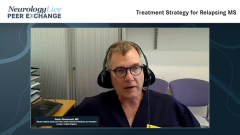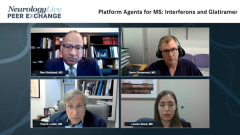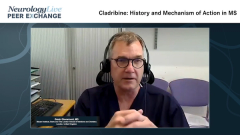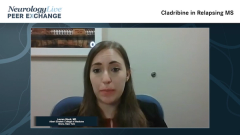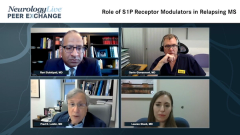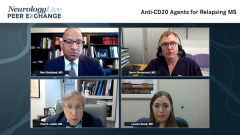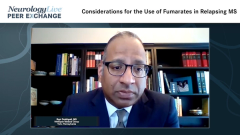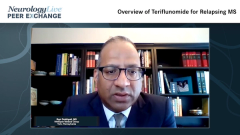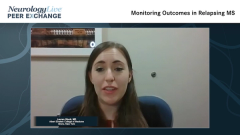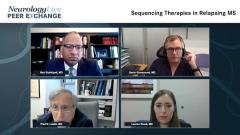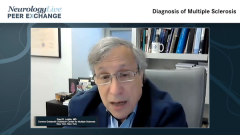
Treatment Strategy for Relapsing MS
Experts in multiple sclerosis (MS) provide an overview of treatment strategies and selection in relapsing MS.
Episodes in this series

Fred D. Lublin, MD: Let’s start talking about some of our therapies. We’re going to start with Gavin. What are some available therapies, in terms of general strategy for treating relapsing MS [multiple sclerosis]?
Gavin Giovannoni, MD: Thanks, Fred. General strategy: First, when I see a new patient, I always have to confirm and make sure the diagnosis is correct. As you mentioned, diagnosis can be incorrect and we know that, in a lot of contemporary series from individual centers, the misdiagnosis rate can be as high as 15%, but it’s usually about 1/20 probability. I always review the diagnosis. That’s just a habit. While I’m doing that, I also do a prognostic profiling. I like to profile. There are a lot of factors, as you know. It was tech multiphasic in terms of multiple systems, whether the patients recover fully from the relapse and what the baseline MRI scan shows opposed to fossa lesion, spinal cord, and bone marrow. There are a lot of these prognostic factors that we know of from natural history studies, and I always like to put people into 3 bins—either they’ve got a good prognostic profile, an indeterminate prognostic profile, or a poor prognostic profile—because that dictates the therapies we’ll approach your treatment with.
For people with a poor prognostic profile, you tend to push for flipping the perimeter and going for the most active treatment—first line, for example. Because I work in the United Kingdom, we have 4 categories of activities. These are the inactive patients who haven’t had any clinical or MRI activity in the last 2 years, and they’re not eligible—under clinical NHS [National Health Service] guidelines—for treatment. If they are active and have had activity in the last 2 years, then there are 3 categories: They are active, highly active, or rapidly evolving severe. Those are ridiculous classifications, but they’re dictated to us by regulators. Diagnostic confirmation, prognostic profile, how active they are, and then you obviously have to look at the personal effect. The 1 I always look at first is how literate this individual is in terms of MS and how he or she understands the disease.
To push somebody down a particular treatment pathway without them understanding MS, understanding the principles of why we’re using these treatments and what the expectation is, then you have to take a step back. You spend time as go. We have ways of doing that. I’m sure most clinics have nurse practitioners or MS nurse specialists, or systems to educate them. While you’re having this discussion, you get a feeling for how risk averse the patient is in terms of some of our therapies. Obviously, personal factors play in. If a young woman is planning to start a family or extend a family, that becomes a driving decision maker about which treatment to go for. If it’s somebody who’s frequently traveling, they don’t want to be on their monthly infusion.
All these personal factors are really important to consider at baseline, but you want to get people on to treatment. How soon is soon? We have the strategy. If somebody is extremely active, and even before we finish the diagnostic process, we would put them on to natalizumab [monoclonal antibody] first line—within days of them coming into our hospital—because you want to get them strong for the disease, so they don’t have any more attacks. That would be 1 extreme. The other extreme is somebody who is not very literate, has a good prognostic profile, and has a lot of factors to consider. We would delay starting treatment until we felt comfortable that this person understood adherence. We would probably direct that person to what I’d call “the old platform therapies,” which are safer. However, we’re very pro patient engagement, allowing them to be part of the decision-making process.
We usually settle on 1 or 2 treatments, send the patient away with literature and information, bring them back, and let them choose their strategy. But underlying that, I’m more in favor of flipping the perimeter. The real-life datasets and phase 3 trial data sets show that those that go on high-efficacy treatments from the beginning do much better than those that walk up to the ladder or have slow maintenance escalation. That doesn’t mean that you’re not necessarily going to do well if you go up the ladder, but you do best if you start on high efficacy.
There has been a shift in prescribing in our centers. I imagine that 65% to 70% of our patients will go on to what I would call upper-tier therapies in the first line, and the other 30% will start on platform. Our go-to platform therapy is dimethyl fumarate. When it comes to high-efficacy treatments, it’s a spread of oral cladribine [Leustatin], ocrelizumab [Ocrevus], natalizumab, and even alemtuzumab, depending on how active they are. But the message I would get across is to be early and effective. When I say effective, it’s getting on top of the disease activity, but later, you’re going to talk about monitoring. That’s to say everything in 5 minutes.
Fred D. Lublin, MD: That’s terrific. Lauren and Ravi, your thoughts on this?
Lauren Gluck, MD: I agree with a lot of what Dr Giovannoni was saying. They come in, and you reassess the history, the exam findings, and the MRIs because often it’s misinterpreted—sometimes overestimating multiple sclerosis, sometimes underestimating it. In identifying the risk factors, that guided decision-making is so important. When people come in, who may have even told you that they could have MS, they are panicked. You have to approach it in steps and make sure that people are digesting the information because—I agree—you can’t put someone on a medicine that changes their immune system, and potentially puts them at risk for infection, if they don’t understand that. If they do, then that’s a very good strategy. We know that advocating for higher-efficacy therapies in a lot of people can offer them a better long-term outcome. It’s a lot of assessment, discussion, and reading the room. All those things are very important.
Fred D. Lublin, MD: Ravi?
Ravi Dukkipati, MD: I agree completely with Dr Giovannoni and Dr Gluck. First and foremost, especially when we receive patients in transfer, it’s not a matter of distrusting the patient or referring physicians. It’s a matter of verifying, objectively, all the data points and confirming the diagnosis because that’s the framework from where we move forward. In terms of strategies for treating MS, compared with when I was training, the key concepts are treating early—once an established diagnosis has been made—and treating with the higher-efficacy drugs early on while optimizing safety, tolerability, and adherence. That’s where individualizing patient medication comes into play.
Fred D. Lublin, MD: Good points.
Gavin Giovannoni, MD: Fred, there’s 1 other thing I didn’t mention. We do have a bit of breathing space when you do what we call “the baseline de-risking strategies,” in terms of the blood work and the viral work. Particularly if you’re going to go for some of the long-term immunosuppressants, we’re doing quite an intensive vaccine review. People must get their vaccines updated and, as an example, pneumococcal vaccine is the 1 we give most, before anti-CD20 therapies. That also allows you a little breathing time—usually about a 6-week window—where you can use that time to educate or improve the health literacy of the individual. The other thing that I find, and would imagine is identical in the United States, is that a lot of these patients have done their own research and have acquired information from various sources. You have to undo some of the information they’ve acquired from Dr Google or whatever Facebook group they’ve been in. I find that taking up more and more of my time in clinic: debunking various myths around MS and the treatments of MS. That’s 1 of the dangers of the democratization of knowledge. There’s a lot of misinformation out there. That’s something that we underestimate.
Fred D. Lublin, MD: Information and misinformation is an important point. Let’s get back to something that Lauren brought up. In the AAN [American Academy of Neurology] treatment guidelines for MS, there was 1 important aspect—perhaps more important than other aspects of those guidelines—suggesting that you should separate the visit where you give the diagnosis, from the visit that you give the therapies. For the reasons you all alluded to, it’s a lot to take in, and you need to have people comfortable with what you told them because when you give someone the diagnosis, you look around the room and see who stopped listening, who looks terrified, and who’s interested in hearing more. You give that information, but then need a second visit to go over the treatment choice. It’s a lot to take in. You’re in that period where you could draw the blood you need for screening and such and even get to the issue of immunization. You can do that anyway.
Thank you all for watching this Neurology Live® Peer Exchange. If you enjoyed the content, please subscribe to our e-newsletters to receive upcoming Peer Exchanges and other great content right in your in-box. Thank you for joining us.
Transcript Edited for Clarity
Newsletter
Keep your finger on the pulse of neurology—subscribe to NeurologyLive for expert interviews, new data, and breakthrough treatment updates.

